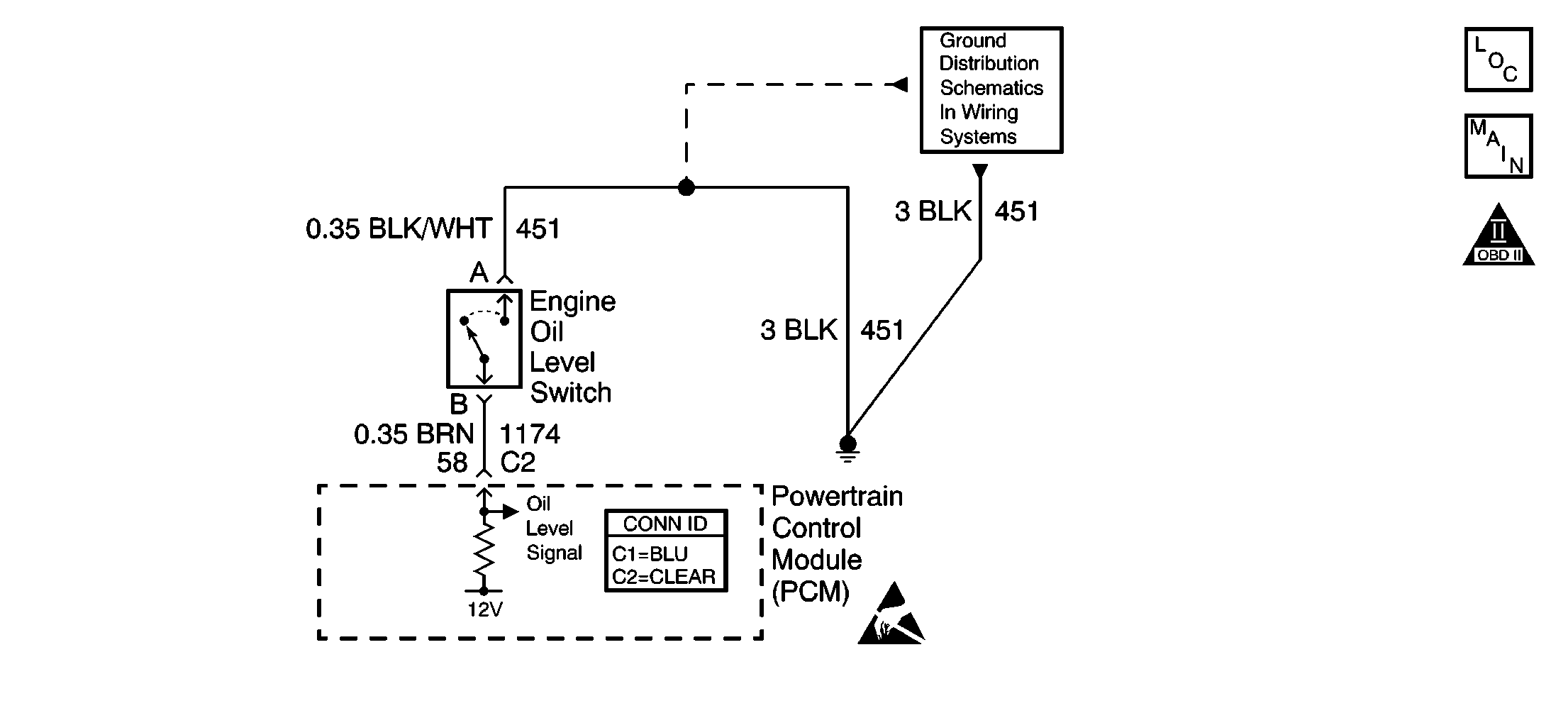
Circuit Description
The engine oil level switch is a simple float switch that is grounded when the engine oil level is OK. The PCM tests the engine oil level switch circuit at startup. Before testing the state of the engine oil level switch, the PCM performs a test routine based on time and engine coolant temperature to ensure that the engine oil has drained back into the sump. To test for low oil level at startup, one of the following conditions must be present:
| • | If the engine coolant temperature was between 15°C (59°F) and 130°C (266°F) at the last key OFF, the engine coolant temperature at key ON must be at least 12°C (22°F) cooler than the engine coolant temperature at the last key OFF. |
| • | If the engine coolant temperature was higher than 100°C (212°F) at the last key OFF, the time between last key OFF and the present key ON must be sufficient to allow the oil to drain back to the sump. The PCM will remain powered up for 10 seconds to ensure that the oil has drained back to the sump. If the key is turned back ON while the PCM is still powered up, the oil level will not be tested. |
The low oil level lamp will be illuminated for approximately 7 minutes when the PCM tests for low oil level and the engine oil level switch indicates that a low oil level condition exists (Engine Oil Level switch circuit not grounded). When the ignition is first turned ON, the PCM commands the low oil level lamp ON for a brief period of time to test the bulb.
Diagnostic Aids
For diagnosis of the instrument panel, perform the System Check in the Instrument Cluster section of Electrical Diagnosis.
Inspect for the following:
A switch stuck closed will indicate oil level parameter OK at all times even in a Low oil condition.
Engine oil level switch circuit: If the problem with the low oil level lamp can not be isolated using the Engine Oil Level Switch Diagnostic table, use the PCM Controlled Lamps Diagnostic table.
Many situations may lead to an intermittent condition. Perform each inspection or test as directed.
Important: : Remove any debris from the connector surfaces before servicing a component. Inspect the connector gaskets when diagnosing or replacing a component. Ensure that the gaskets are installed correctly. The gaskets prevent contaminate intrusion.
| • | Loose terminal connection |
| - | Use a corresponding mating terminal to test for proper tension. Refer to Testing for Intermittent Conditions and Poor Connections , and to Connector Repairs in Wiring Systems for diagnosis and repair. |
| - | Inspect the harness connectors for backed out terminals, improper mating, broken locks, improperly formed or damaged terminals, and faulty terminal to wire connection. Refer to Testing for Intermittent Conditions and Poor Connections , and to Connector Repairs in Wiring Systems for diagnosis and repair. |
| • | Damaged harness--Inspect the wiring harness for damage. If the harness inspection does not reveal a problem, observe the display on the scan tool while moving connectors and wiring harnesses related to the sensor. A change in the scan tool display may indicate the location of the fault. Refer to Wiring Repairs in Wiring Systems for diagnosis and repair. |
| • | Inspect the powertrain control module (PCM) and the engine grounds for clean and secure connections. Refer to Wiring Repairs in Wiring Systems for diagnosis and repair. |
If the condition is determined to be intermittent, reviewing the Snapshot or Freeze Frame/Failure Records may be useful in determining when the DTC or condition was identified.
